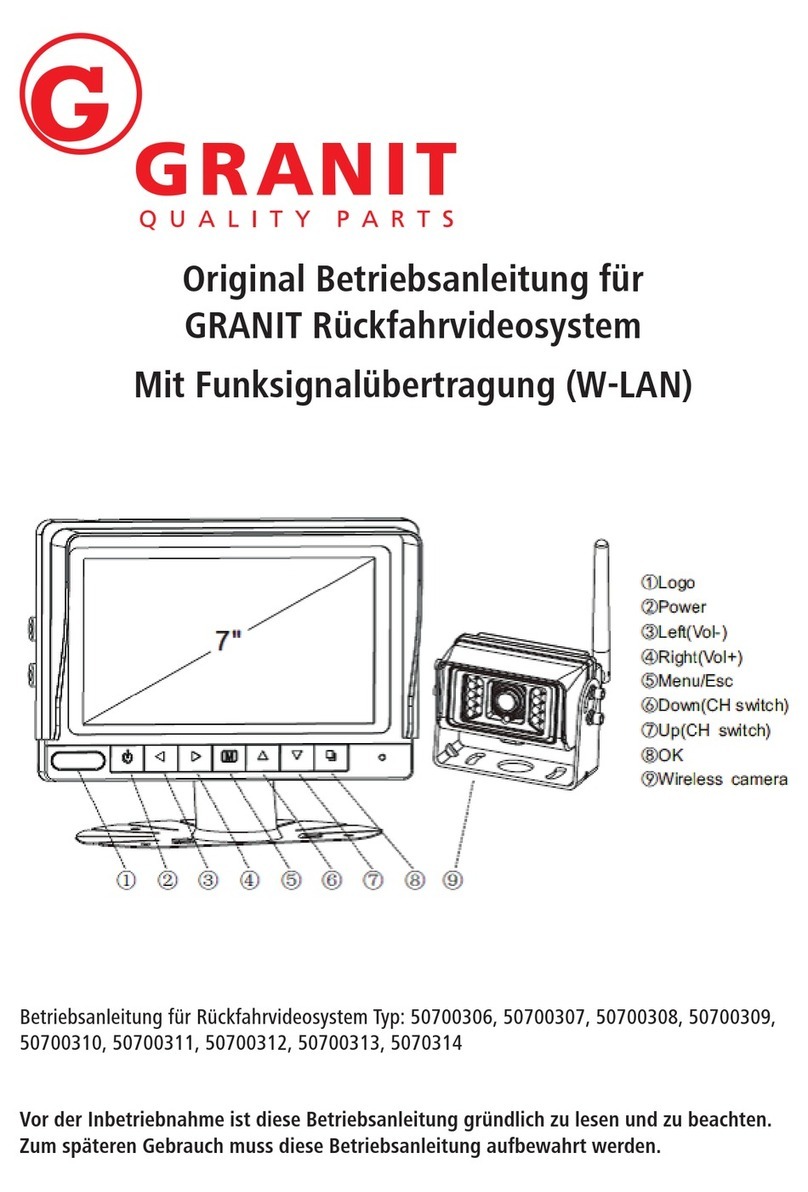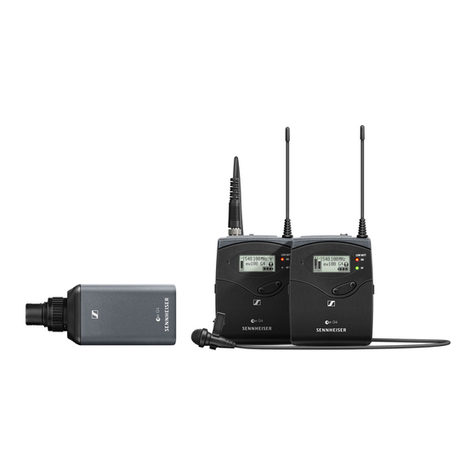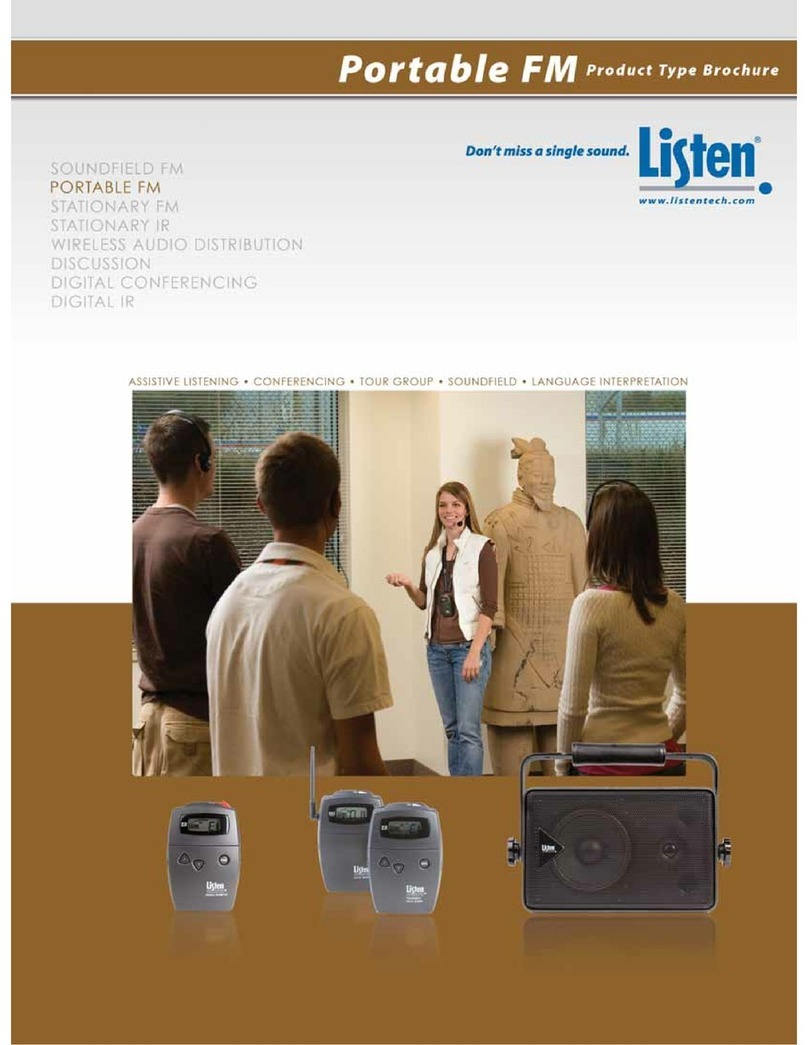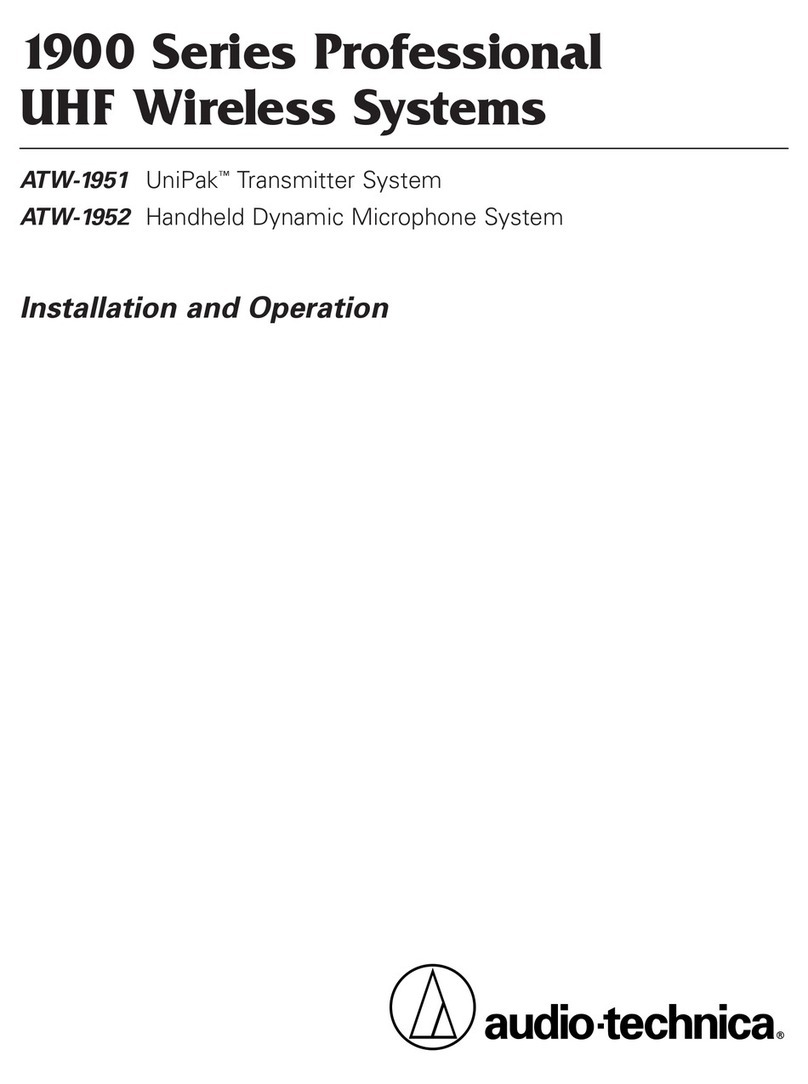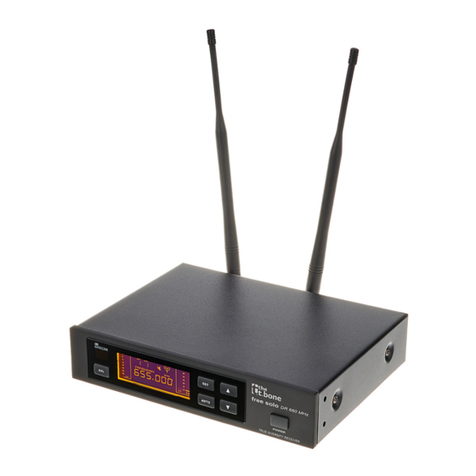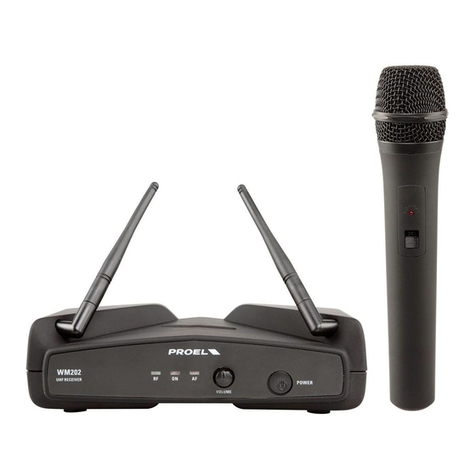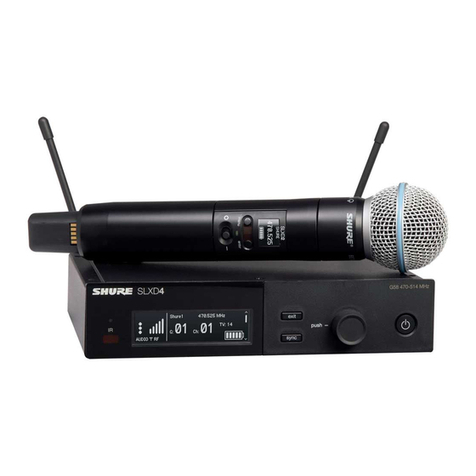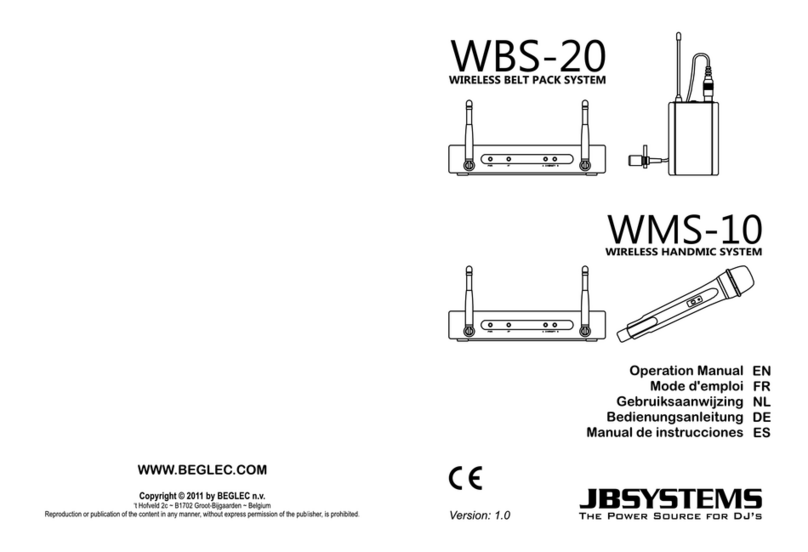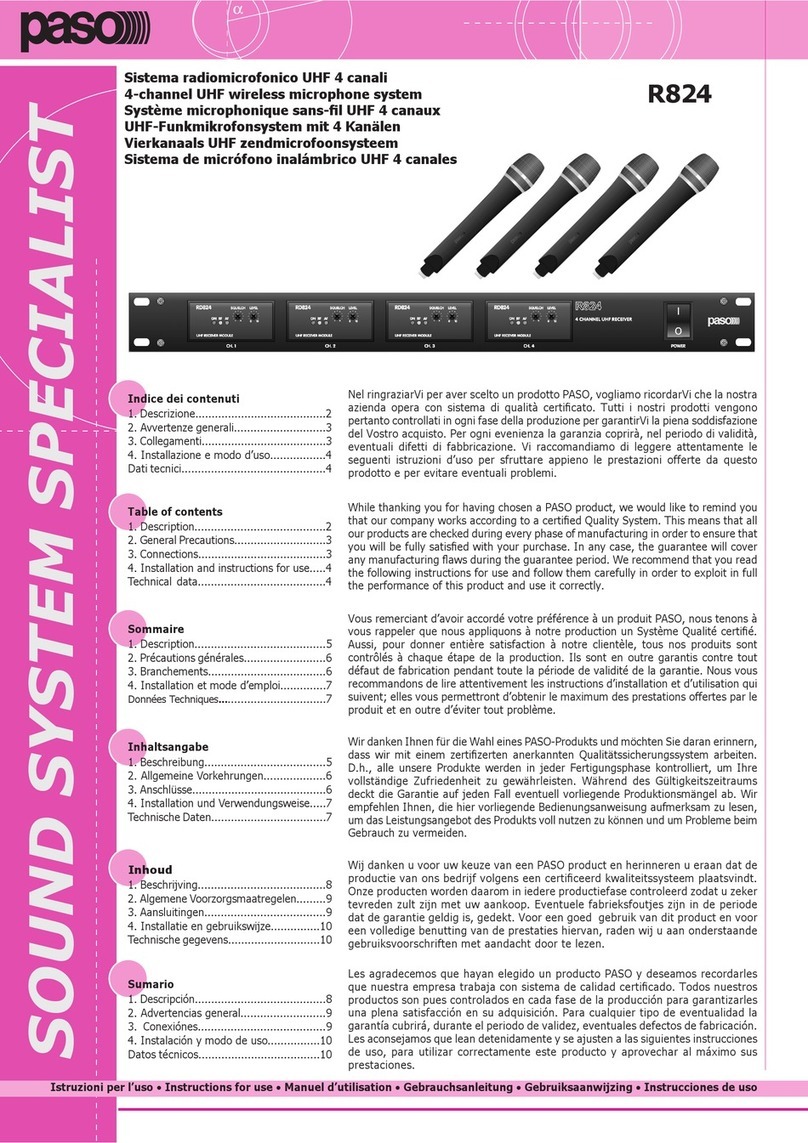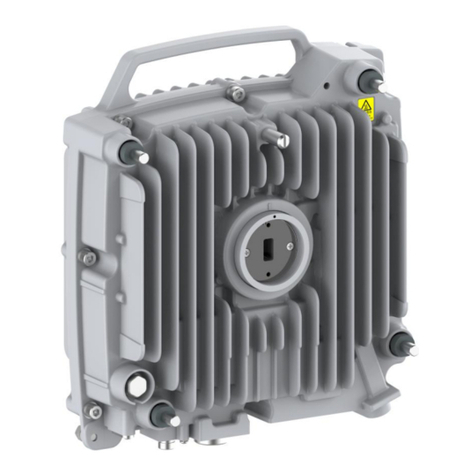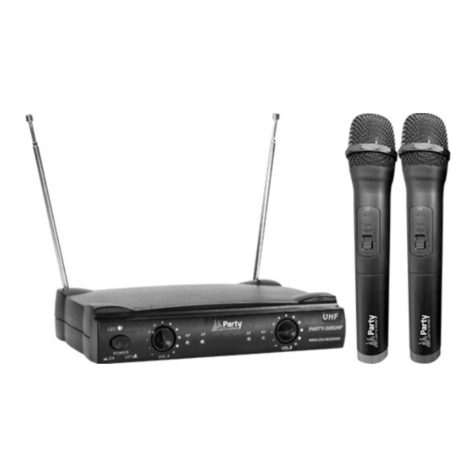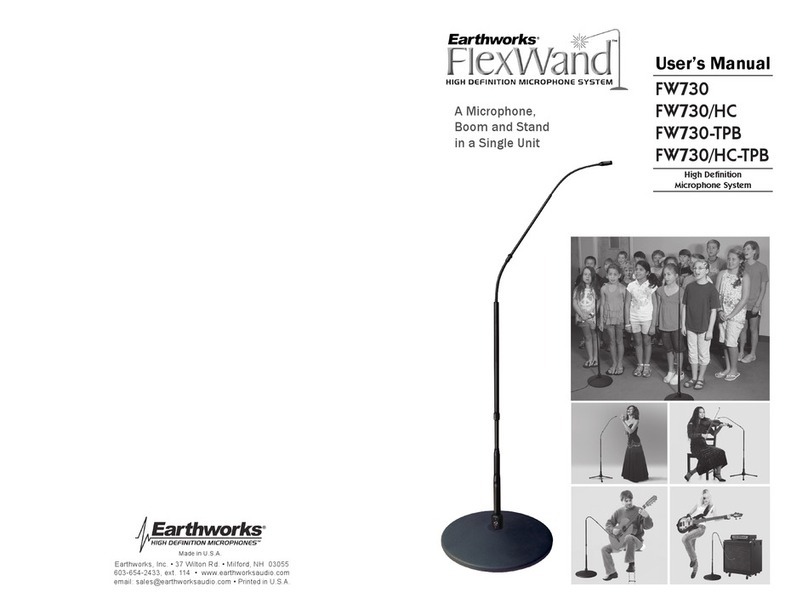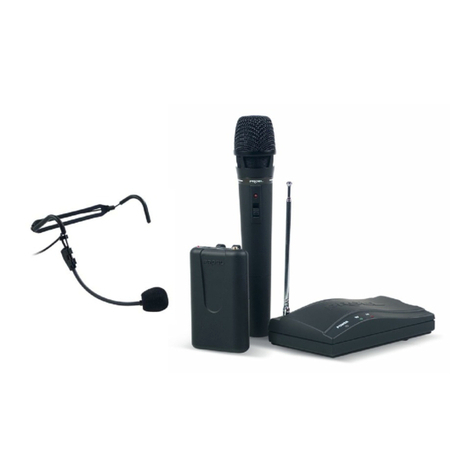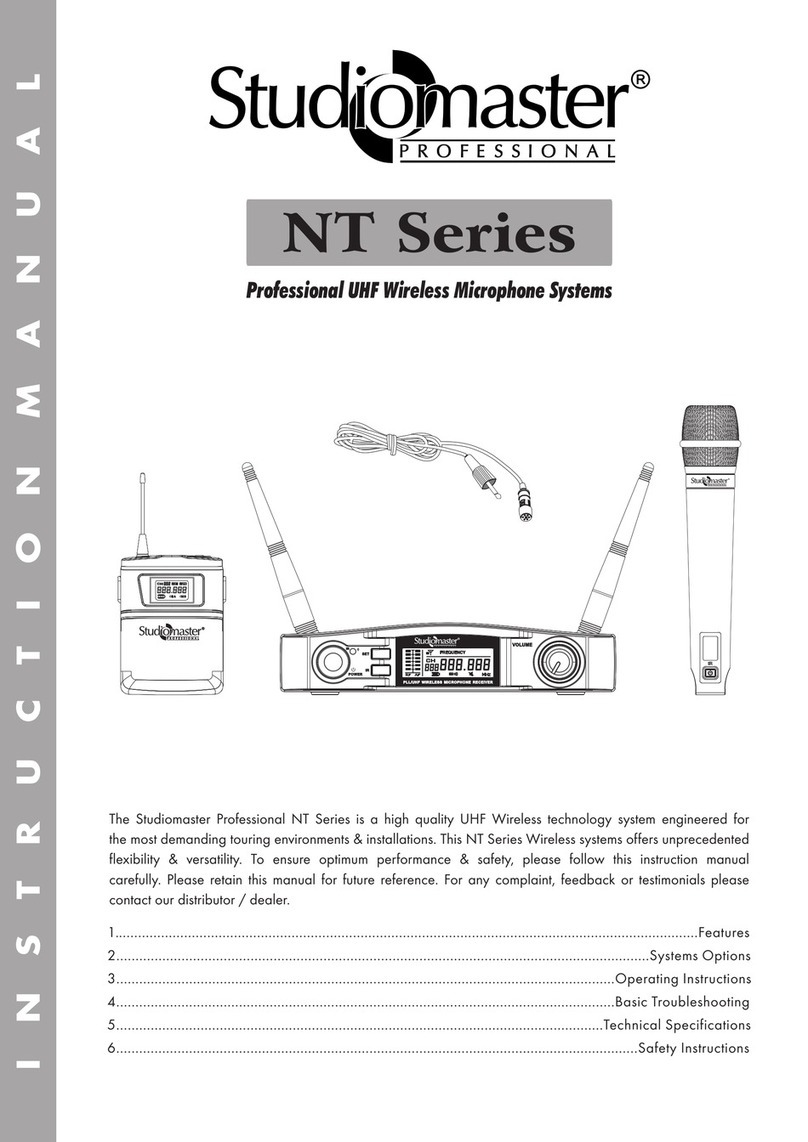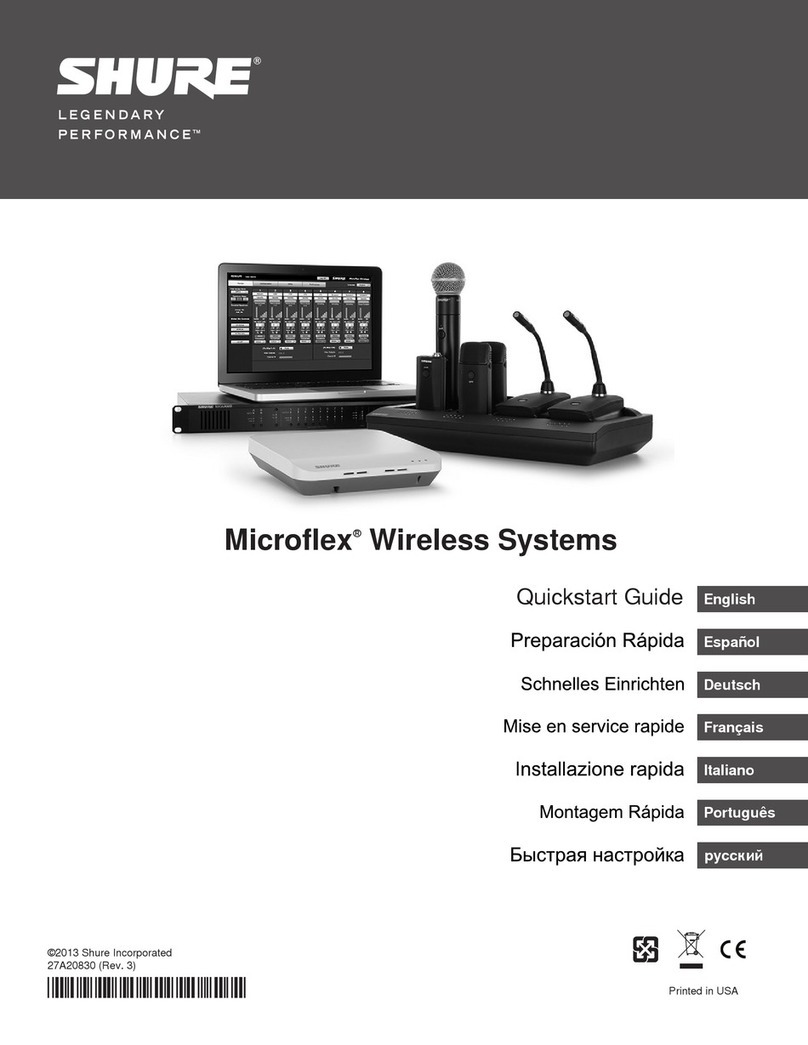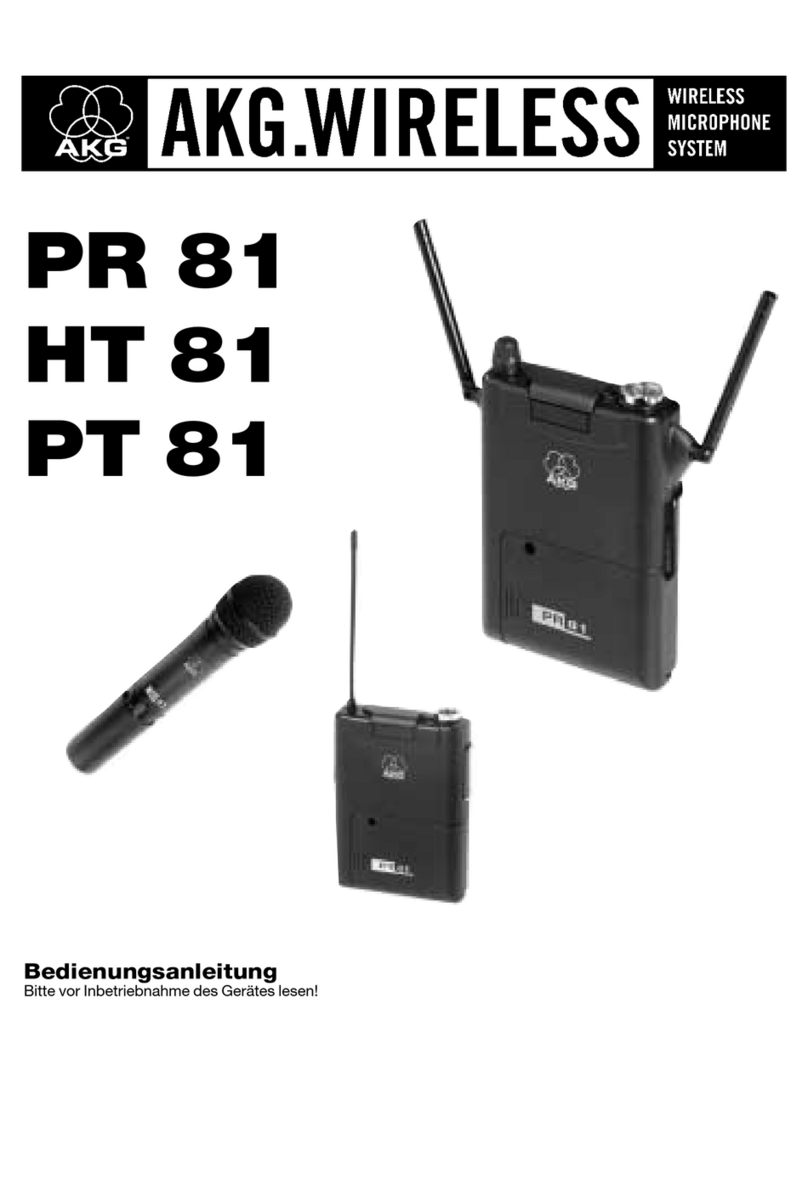FiveO WiP 160 User manual

W iP 160/160 C
Wireless microphone systems
Sistema UHF senza fili
ENGLISHITALIANO
[EN] owNEr’s maNual
[IT]
Manuale d’uso
(pag. 2)
(pag. 10)

Owner’s manual | WiP 160/160C Wireless Microphone Systems WiP 160/160C Wireless Microphone Systems | Owner’s manual
2
W iP 160/160 C
WARNING
In order to protect your own and others’ safety and
to avoid invalidation of the warranty of this product,
please read this section carefully before operating
this product.
∙ Read all documentation before operating your equipment.
∙ Retain all documentation for further reference, supplying
it to any user.
∙ Read all warnings and follow all instructions contained in
this instruction manual.
∙ Damages caused by connecting to improper AC voltage
are not covered by any warranty. Mains voltage must
correspond to rear unit label.
∙ AlwaysoperatetheunitwiththeACgroundwireconnected
to theelectrical systemground.Precautions shouldbe taken
toavoidequipmentfaulty,improperorinefficientgrounding.
∙ Clean the device only when not connected to the mains.
For cleaning, use a dry cloth.
∙ To reduce the risk of fire or electric shock, do not use the
device near water and don’t expose it to rain.
∙ Useonlythesuppliedpoweradapter,disconnectingitduring
lightning storms or when unused for long periods of time.
∙ To prevent overheating, the devices must be placed away
from sources of heat (radiators, heat registers, stoves,
amplifiers or other equipment) nor be exposed to direct
sunlight.
∙ Referallservicingtoqualifiedandauthorizedpersonnelonly.
Servicing is required when the device has been damaged in
any way, whether in liquid has been spilled or objects have
fallen into, the devices were exposed to rain or moisture,
or the devices does not operate properly or have fallen.
CAUTION
This product does not contain user serviceable parts. In order
to prevent fire and/or electrical shock, never disassemble it.
For maintenance and servicing always refer to the official
FiveO by Montarbo®Distributor in your Country or to qua-
lified personnel specifically authorised by the Distributor.
WEEE | Waste from Electrical and Electronic Equipment
ATTENTION!
The crossed out wheeled bin symbol that can be found on this
product means that the product is covered by the Waste from
Electrical and Electronic Equipment Directive.
The symbol is intended to indicate that waste from
electrical and electronic equipment must be subject to a selective collec-
tion. For more details on available collection facilities please contact your
local government office or the retailer where you purchased this product.
The solid bar underneath indicates that the product has been put on the
market after 13th August 2005.
INFORMATION ON PROPER DISPOSAL
Information on Disposal for Users (private households)
In the European Union | Attention: If you want to dispose of this
equipment, please do not use the ordinary dust bin! Used electrical and
electronic equipment should not be disposed of via the normal household
waste stream but must be treated separately and in accordance with le-
gislation that requires proper treatment, recovery and recycling of used
electrical and electronic equipment. Following the implementation by
member states, private households within the EU states may return their
used electrical and electronic equipment to designated collection facilities
free of charge*. In some countries* your local retailer may also take back
your old product free of charge if you purchase a similar new one. *Plea-
se contact your local authority for further details.
In other Countries outside the EU | If you wish to dispose of this pro-
duct, please contact your local authorities and ask for the correct method
of disposal.
In Switzerland | Used electrical or electronic equipment can be returned
free of charge to the dealer, even if you don’t purchase a new product.
Further collection facilities are listed on the homepage of www.swico.
ch or www.sens.ch.
Information on Disposal for Professional Users
In the European Union | If the product is used for business purposes
and you want to discard it: please contact your FiveO by Montarbo®de-
aler who will inform you about the take-back of the product. You might
be charged for the costs arising from take-back and recycling. Small pro-
ducts (and small amounts) might be taken back by your local collection
facilities.
In Spain | Please contact the established collection system or your local
authority for takeback of your used products.
In other Countries outside the EU | Please contact your local authori-
ties and ask for the correct method of disposal.
Important precautIons

Owner’s manual | WiP 160/160C Wireless Microphone Systems WiP 160/160C Wireless Microphone Systems | Owner’s manual
3
ENGLISH
contents
Introduction 4
Features 4
All systems include 4
Receiver 5
Handheld transmitter 6
Body-pack transmitter (WiP 160C only) 7
Tips 8
Troubleshooting 8
Specifications 9
pacKaGe contents
Receiver
Hand-held transmitter
Body-pack transmitter (WiP 160C only)
Headset microphone (WiP 160C only)
AA-size batteries
6.35 mm (¼”) Jack-Jack cable
Power adapter
ABS protection case
Owner’s manual
Warranty certificate

Owner’s manual | WiP 160/160C Wireless Microphone Systems WiP 160/160C Wireless Microphone Systems | Owner’s manual
4
W iP 160/160 C
INTRODUCTION
First of all, thank you for choosing a product FiveO by Montarbo®. This line has been designed for those who
want to set-up their user friendly audio sound system with excellent performances and outstanding value. Furthermore,
we manufactured all these products to assure you satisfying and reliable operation over many years. Our WiP 160 is
a professional UHF wireless microphone set including an hand-held as well as a belt-pack and a headset microphone.
This versatile single channel, antenna diversity receiver will provide you 16CH of wireless transmission. Please, in order
to enjoy each feature of your new microphone thus achieving the best sonic performances, take a few moments
to carefully read these instructions. For further information about your microphone, please check our website
www.fiveo.it, or send an email to: mail@fiveo.it
FEATURES
WiP 160 microphones sound character is perfectly tailored for female and male vocals. The choice among 16
transmitting and receiving channels will provide you performances without RFI. Being aware of the heavy use your
WiP 160 should run in most demanding live applications, we manufacture it in a sturdy way. Please, be careful
handling your WiP 160 microphones. Despite the ruggedness of our manufacture, the internal microphone
diaphragms are very thin and these diaphragms could suffer for mechanical shocks and for excessive moisture and
dust collecting. Finding the optimal microphone placement is basically a process requiring trials; so make your own
experience starting from mic tech specs and your knowledge, continuously using your musical sensibility and your ears.
To achieve best sonic results, we suggest you to use your WiP 160 hand-held mic very close to your mouth, you
should experience some proximity effect, boost of lower frequencies, but increasing the distance you risk feedback and
other instruments pick-up. The headset mic will be used very close to your mouth bending the mic boom, while the
lavalier microphone will be attached to speaker clothes. On stage use, please be careful to wedge monitor placement,
since you could incur in feedback with very high sound pressure level!
ALL SYSTEMS INCLUDE:
1 x Receiver
1 x Hand-held transmitter
1 x Body-pack transmitter (WiP 160C only)
1 x Headset microphone (WiP 160C only)
2 x “AA” size batteries
1 x 1/4” cable
1 x Power adapter
1 x ABS protection and transport case
1
2
3
4
5
6
7
1
2
3
4
5
6
7

Owner’s manual | WiP 160/160C Wireless Microphone Systems WiP 160/160C Wireless Microphone Systems | Owner’s manual
5
ENGLISH
RECEIVER
FRONT PANEL
1IR – Infrared port. It’s the emission point of IR
signal to match channel with the transmitter.
AF – Audio signal indicator.
RF – Radio Frequency indicator. It’s lit when
the receiver detects a transmitter on the selected
IR channel.
Display. It displays the channel number.
Volume control knob.
SELECT – Channel selector.
Read «System Setup» below.
ASC – Automatic Search of Channel button.
Press it to initiate matching between receiver and
transmitter.
AC adapter jack.
Unbalanced output Jack (6.35mm - ¼”)
[!] Attention: in order to rationalize the costs
the written “2 IN 1 MIX” is used for the whole
wireless systems range. However, when using the
single channel models (WiP 160/160 C) the main
out works indeed as a single output.
2
3
4
5
6
7
1 2 3 4 5
6 7
8 9
REAR PANEL
8
9
System Setup
Receiver Programming
By pressing the ASC button, the receiver will transmit IR signal to transmitter for automatic frequencies
matching.During IR signal transmission, the display will flash. The display character will be firmly lit when
receiver and transmitter frequencies will be locked.
Press the SELECT button to select operating channel, when the receiver will detect a working transmitter, the RF LED
will remain lit and the AF LED will be lit receiving signal from transmitter. Turn the receiver volume control clockwise
to raise the output volume, or counter-clockwise to decrease the output volume.
Note: Using multiple systems, it’s better to set the maximum channel spacing among units.
You can use up to 8 WiP systems simultaneously.

Owner’s manual | WiP 160/160C Wireless Microphone Systems WiP 160/160C Wireless Microphone Systems | Owner’s manual
6
W iP 160/160 C
HANDHELD TRANSMITTER
1Microphone capsule.
Power/Low battery indicator.
Green: Ready
Red: Low battery.
ON/OFF switch.
Battery cover.
IR port. Receives infrared beam to match
receiver and transmitter channel.
2
3
4
5
1
2 3
4 5
Handheld Transmitter Setup
Match the channel between transmitter and receiver
by aligning the infrared(IR) ports and pressing the
ASC button.
Note: Make sure the infrared (IR) ports of the
receiver and transmitter are closely aligned. When
using multiply systems, only one transmitter IR
port should be matched at a time.
Replacing Batteries
Expectedlifefortwoalkalinebatteriesisabout10
hours. As thebattery indicator on the screen keeps
glowing , the batteries should be immediately
changed (as shown below).
open close

Owner’s manual | WiP 160/160C Wireless Microphone Systems WiP 160/160C Wireless Microphone Systems | Owner’s manual
7
ENGLISH
BODYPACK TRANSMITTER (WiP 160C only)
Replacing batteries
Expectedlifefortwoalkalinebatteries
is about 10 hours. As the battery
indicator on the screen begins
glowing, the batteries should be
immediately changed(as shown
above).
3 4 5
1Antenna.
Power/Low battery indicator.
Green: Ready
Red: Low battery.
Microphone Input Jack.
Gain adjustment selector.
Three settings are available.
Mic: microphone.
0: Guitar with passive pickups.
-10dB: Guitar with active pickups.
ON/STANDBY/OFF selector.
ON/OFF switch. When it’s in its
middle position, the transmitter
is muted
IR port. Receives infrared beam
generated by the receiver to
match channel.
2
3
4
5
1
2
6
Wearing the Belt-pack Transmitter:
Clip the transmitter to belt [A], or slide a guitar strap through the
transmitter clip [B], as shown in the left. For best results, slide the
transmitter until the belt 1 is firmly pressed against the base of the clip.
6
[A] [B]
open/close
Body-pack Transmitter Setup
Match the channel between transmitter and receiver by aligning the
infrared (IR) ports and pressing the ASC button. Note: Make sure
the infrared (IR) ports of the receiver and transmitter are closely
aligned. When using multiply systems, only one transmitter IR
port should be matched at once.

Owner’s manual | WiP 160/160C Wireless Microphone Systems WiP 160/160C Wireless Microphone Systems | Owner’s manual
8
W iP 160/160 C
TIPS
∙
Maintain a line of sight between transmitter and antenna.
∙
Avoid placing the receiver near metal surfaces or any digital equipment (CD players, computers, etc).
∙
Keep the receiver away from the wall and over 1m to the ground.
∙
Transmitting devices such as cellular phones and two-way radio may interfere with wireless audio transmission.
Keep the transmitter and receiver away from this and other potential sources of interferences.
TROUBLESHOOTING
Issue Indicator Status Solution
No sound or faint
sound
No Transmit
Turn on transmitter.
Make sure the +/- indicator on battery match the
transmitter terminals.
No Receive
Make sure AC adapter is securely plugged into electrical
outlet and into DC input connector on receiver rear
panel.
Receiver RF indicator glows
Turn the receiver ON.
Turn up the Gain adjustment switch in the transmitter.
Check the power connection of the receiver
and amplifier or mixer.
Receiver RF indicator OFF,
transmitter ON
Check the receiver and transmitter whether use the
same channel.
Take the receiver away from any metal object.
Check the line of sight between receiver and transmitter.
Move the transmitter closer to the receiver.
The battery power indicator
light flashes Replace transmitter batteries.
Distortion or
unwanted noise bursts
Receiver display indicators
antenna activity
Remove nearby sources of RF interference (CD players,
computers, digital effects, in-ear monitor systems, etc.).
Distortion level
increases gradually
Receiver RF indicator OFF,
transmitter ON Replace transmitter batteries.
Sound level different
from cabled guitar or
microphone, or when
using different guitars
Adjust transmitter gain and receiver volume as
necessary.

Owner’s manual | WiP 160/160C Wireless Microphone Systems WiP 160/160C Wireless Microphone Systems | Owner’s manual
9
ENGLISH
SPECIFICATIONS
SYSTEM
Frequency Range and Transmitter Output level
RECEIVER
Operating Range under Typical Condition: 50m (150 ft.)
Note: actual range depends on RF signals
absorption, reflection and interference.
∙
Audio Frequency Response (±3 dB): 60Hz÷16kHz
∙
TotalHarmonicDistortion(±30kHzdeviation,1kHztone):<1%
∙
Dynamic Range: >90 dB (A weighted)
∙
Operating Temperature Range: -10°C to +50°C
Note: battery characteristics may limit the range.
∙
Audio Output Level Maximum (ref. ±30 kHz, 1 kHz)
1/4” connector ( 3kΩ load): –18dBV
∙
Output Impedance: 1/4” connector 1kΩ
∙
Sensitivity (intermediate frequency adjustment audio
noise output: < –90dBm
∙
Image Rejection: >60dB
∙
Dimensions (WxHxD): 210x116x42 mm
∙
Power Requirements: 12/18V DC @300mA, supplied by
external power supply
Band Range Transmitter RF level
UB 630÷660 MHz 13dBm
HANDHELD TRANSMITTER
∙
Audio Input Level maximum: 0dBV
∙
Dimensions(includingthemicrophone):245xø47 mm
∙
Weight: 195g
∙
BatteryType:2xAAAlkalineorrechargeable batteries.
∙
Battery Life: >10 hours (Alkaline)
BODY PACK TRANSMITTER
∙
Audio Input Level Maximum: 0dBV ~ +20dBV
∙
Gain adjustment Range: 20dB
∙
Input Impedance: 470kΩ
∙
Dimensions (WxHxD): 65x105x23 mm
∙
Weight: 80g without batteries
∙
Power Requirement: 2 x AA-size Alkaline
or rechargeable batteries
∙
Battery life: >10 hours (Alkaline)

10
W iP 160/160 C
Manuale d’uso | WiP 160/160C Sistema UHF senza fili WiP 160/160C Sistema UHF senza fili | Manuale d’uso
ATTENZIONE
Nell’interesse della propria e della altrui sicurezza,
e per non invalidare la garanzia, si raccomanda una
attenta lettura di questa sezione prima di utilizzare
il prodotto.
∙ Leggete tutta la documentazione prima di utilizzare
l’apparecchiatura.
∙ Conservate tutta la documentazione per ogni ulteriore
consultazione, fornendola ad eventuali utilizzatori.
∙ Osservate tutte le avvertenze e seguite tutte le istruzioni
contenute in questo manuale di istruzioni.
∙ Danni causati da errata connessione a tensione alternata
non sono coperti da garanzia. La tensione di rete deve
corrispondere all’etichetta posteriore.
∙ Utilizzate sempre l’unità con il cavo di massa di corrente
collegato alla terra dell’impianto elettrico. Prendete
precauzioniper evitare unamessa aterra difettosa,scorretta
o inefficiente.
∙ Pulite i dispositivi solo quando non sono collegati alla rete
elettrica. Per la pulizia usate un panno asciutto.
∙ Per ridurre il rischio di incendi o scosse elettriche, non
utilizzate i dispositivi e gli alimentatori vicino all’acqua e
non esporli alla pioggia o all’umidità. .
∙ Utilizzare esclusivamente l’alimentatore in dotazione,
scollegandolo durante i temporali o se inutilizzato per
lunghi periodi di tempo.
∙ Per prevenire surriscaldamento, i dispositivi devono
esser distanti da fonti di calore (radiatori, caloriferi, stufe
amplificatori o altri apparecchi) né esser esposti alla luce
diretta del sole.
∙ Perl’assistenzarivolgersiapersonalequalificato.L’assistenza
è necessariase idispositivisonostati danneggiatiinqualsiasi
modo, seall’internoèstatoversato del liquidoo sonocaduti
oggetti, i dispositivi sono stati esposti a pioggia o umidità,
non funzionino correttamente o sono caduti.
NOTA BENE
Per qualsiasi intervento di manutenzione o riparazione,
rivolgetevi alla Elettronica Montarbo srl e/o a personale
altamente qualificato specificamente segnalato da questa.
Direttiva RAEE
ATTENZIONE!
Il prodotto è contrassegnato da questo simbolo che
segnala di non smaltire le apparecchiature elettriche ed
elettroniche tramite la normale procedura di smaltimento
dei rifiuti domestici. Per questi prodotti è previsto un sistema
di raccolta differenziato in conformità alla legislazione che richiede il
trattamento, il recupero e il riciclaggio adeguato dei suddetti prodotti. Per
maggiori informazioni si prega di contattare l’autorità locale competente.
La barra nera sotto il simbolo indica che il prodotto è stato immesso sul
mercato dopo il 13 agosto 2005.
INFORMAZIONI PER UN CORRETTO SMALTIMENTO
Per gli utenti privati
Nell’Unione europea | Attenzione: Per smaltire il presente dispositivo,
non utilizzare il normale bidone della spazzatura! Le apparecchiature
elettriche ed elettroniche usate devono essere gestite a parte e in
conformità alla legislazione che richiede il trattamento, il recupero e il
riciclaggio adeguato dei suddetti prodotti. In seguito alle disposizioni
attuate dagli Stati membri, i privati residenti nella UE possono conferire
gratuitamente le apparecchiature elettriche ed elettroniche usate a centri
di raccolta designati*. In alcuni paesi (*), anche il rivenditore locale
può ritirare gratuitamente il vecchio prodotto se l’utente acquista un
altro nuovo di tipologia simile. *Per maggiori informazioni si prega di
contattare l’autorità locale competente.
In paesi che non fanno parte dell’UE | Contattare le autorità locali e
informarsi sul metodo di smaltimento corretto.
In Svizzera | Le apparecchiature elettriche o elettroniche usate possono
essere restituite gratuitamente al rivenditore, anche se non si acquista un
prodotto nuovo. Altri centri di raccolta sono elencati sulle homepage di
www.swico.ch o di www.sens.ch.
Per gli utenti professionali
Nell’Unione europea | Attenzione: Se il prodotto è impiegato a scopi
professionali, procedere come segue per eliminarlo: contattare il proprio
rivenditore FiveO by Montarbo®che fornirà informazioni circa il ritiro del
prodotto. Potrebbero essere addebitate le spese di ritiro e riciclaggio.
Prodotti piccoli (e quantitativi ridotti) potranno essere ritirati anche dai
centri di raccolta locali.
In Spagna | Contattare il sistema di raccolta ufficiale o l’ente locale
preposto al ritiro dei prodotti usati.
In paesi che non fanno parte dell’UE | Contattare le autorità locali e
informarsi sul metodo di smaltimento corretto.
aVVertenZe

11
ITALIANO
Manuale d’uso | WiP 160/160C Sistema UHF senza fili WiP 160/160C Sistema UHF senza fili | Manuale d’uso
InDIce
Introduzione 12
Caratteristiche 12
Dotazione 13
Ricevitore 14
Radiomicrofono 15
Trasmettitore tascabile (solo WiP 160C) 16
Consigli 17
Soluzione dei problemi 17
Caratteristiche 18
contenuto ImBaLLo
Ricevitore
Trasmettitore radiomicrofono
Trasmettitore tascabile body-pack (solo WiP 160C)
Microfono ad archetto (solo WiP 160C)
Batterie di tipo “AA”
Cavo terminato con jack da 6,35 mm (¼”)
Trasformatore di alimentazione
Valigetta di protezione e trasporto in ABS
Manuale d’uso
Certificato di garanzia

12
W iP 160/160 C
Manuale d’uso | WiP 160/160C Sistema UHF senza fili WiP 160/160C Sistema UHF senza fili | Manuale d’uso
INTRODUZIONE
Vi ringraziamo per aver scelto un prodotto della linea FiveO by Montarbo®. Questa linea di prodotti è stata
progettata e realizzata per quanti desiderano acquistare apparecchi audio professionali con eccellenti prestazioni e con
grande valore aggiunto. Abbiamo realizzato tutti gli articoli con grande accuratezza, per assicurarne il funzionamento
soddisfacente ed affidabile per molti anni. Il sistema WiP è costituito dai modelli WiP 160 e WiP 160C. Entrambi
dispongono di un trasmettitore e ricevitore in banda UHF mono canale dotato di 16 frequenze selezionabili. Forniti
di caratteristiche molto utili, comprendono un display digitale a 7 segmenti con pulsanti light-touch ed interfaccia
plug’n’play molto intuitiva, ricerca e sincronizzazione dei canali ad infrarossi. Il modello WiP 160 è un radiomicrofono
con una capsula cardioide la cui direttività consente l’uso anche con elevate pressioni sonore dai monitor e dall’impianto.
La versione COMBO – WiP 160C – è fornita anche di un trasmettitore tascabile ed un pratico microfono ad archetto
con caratteristica polare omnidirezionale. Entrambi i modelli sono dotati di diversi accessori ed una robusta valigetta
in ABS per il trasporto e l’immagazzinamento sicuro.
Al fine di sfruttare al meglio le caratteristiche del vostro WiP 160, vi raccomandiamo la lettura attenta di queste
istruzioni.
Per ulteriori informazioni consultate il nostro sito web www.fiveo.it, o inviate una mail a: mail@fiveo.it
CARATTERISTICHE
La caratteristica sonora del radiomicrofono WiP 160 lo rende ideale per voci femminili e maschili. La scelta tra i
16 canali di ricetrasmissione ed il sistema di ricerca automatica della frequenza è in grado di offrire prestazioni senza
interferenze da radio frequenze.
Trovare il posizionamento ottimale del microfono è un processo fondamentalmente che richiede prove, pertanto
fate la vostra esperienza partendo dalle caratteristiche tecniche del microfono e dalla vostra conoscenza, usando
continuamente la vostra sensibilità musicale ed il vostro udito.
Vi consigliamo di utilizzare il radiomicrofono vicino alla bocca, anche se ciò provocherà il cosiddetto effetto di prossimità,
ossia un incremento delle frequenze basse, e si rischia l’accentuazione delle labiali ma aumentando la distanza si rischia
l’innesco con eventuali monitor e/o l’impianto principale e di captare il segnale di altri strumenti.
Il microfono headset si usa molto vicino alla bocca, piegando l’archetto che supporta la capsula del microfono e
sfruttando l’utile spugnetta anti-pop che protegge la capsula riducendo nello stesso tempo le labiali.
Maneggiate con cura i microfoni in dotazione, nonostante la robustezza della nostra costruzione, sono dotati di un
diaframma molto sottile, il quale potrebbe risentire di urti, eccessiva umidità e depositi di polvere.
Il sistema WiP160 è ideale per molte applicazioni, come concerti, fitness o speakeraggio e spesso andrà incontro ad
un uso gravoso, pertanto in fase progettuale ed in fase costruttiva abbiamo rivolto grande attenzione alla solidità.
ATTENZIONE: Per uso scenico si prega di fare attenzione al posizionamento del monitor poiché con alti
livelli di pressione sonora si potrebbe incorrere in un feedback!

13
ITALIANO
Manuale d’uso | WiP 160/160C Sistema UHF senza fili WiP 160/160C Sistema UHF senza fili | Manuale d’uso
DOTAZIONE
Tutti i sistemi comprendono:
1 x Ricevitore
1 x Trasmettitore radiomicrofono
1 x Trasmettitore tascabile body-pack (solo WiP 160C)
1 x Microfono ad archetto (solo WiP 160C)
2 x Batterie di tipo “AA”
1 x Cavo terminato con jack da 6,35 mm (¼”)
1 x Trasformatore di alimentazione
1 x Valigetta di protezione e trasporto in ABS
1
2
3
4
5
6
7
1
2
3
4
5
6
7

14
W iP 160/160 C
Manuale d’uso | WiP 160/160C Sistema UHF senza fili WiP 160/160C Sistema UHF senza fili | Manuale d’uso
RICEVITORE
PANNELLO ANTERIORE
1IR. PortaInfrarossi.È il punto di emissionedelsegnale
IR per sincronizzare il canale con il trasmettitore.
AF. Indicatore di presenza del segnale audio.
RF. Indicatorediradio-frequenza.Siaccendequando
il ricevitore rileva un trasmettitore sul canale IR
selezionato.
Display. Mostra il numero del canale in ricezione.
Volume. Manopola di controllodelvolumeinuscita.
SEL. Selettore del canale. Leggete il capitolo
«Configurazione del sistema».
ASC. Tastodiricercaautomaticadelcanale. Premereper
avviarel’interfacciamentotraricevitore e trasmettitore.
DC 12-18V Presa di alimentazione per il trasformatore
fornito in dotazione. In caso di perdita o guasto del
trasformatore, acquistarne uno con gli stessi valori.
UNBAL OUT. Jack di uscita sbilanciato da 6,35 mm.
[!] Attenzione: al fine di razionalizzare i costi di
produzione abbiamo preferito mantenere la scritta “2
IN 1MIX” per tutti i modelli della serie WiP. Pertanto,
quandoutilizzatericevitori monocanale(WiP160/160C)
l’uscita sbilanciata è singola e non miscelata.
2
3
4
5
6
7
1 2 3 4 5
6 7
8 9
PANNELLO POSTERIORE
8
9
IMPOSTAZIONE DEL SISTEMA
Programmazione del ricevitore.
PremendoiltastoASCilricevitoretrasmetteilsegnaleIRaltrasmettitoreperlaselezioneautomaticadellafrequenza.
DurantelatrasmissionedelsegnaleIR,ildisplaylampeggia.Ilcaratteredeldisplayresteràaccesoinmodofissoquando
lefrequenzedel ricevitoreedeltrasmettitoresarannosincronizzate.PremeteiltastoSELper selezionareilcanale
operativo; quando il ricevitore rileverà un trasmettitore attivo, il LED RF resterà acceso e il LED AF sarà illuminato alla
ricezione del segnale dal trasmettitore. Ruotate il controllo del volume del ricevitore in senso orario per aumentare il
volume di uscita, o in senso antiorario per diminuire il volume in uscita.
Nota: Utilizzando più sistemi, è meglio impostare la spaziatura massima delle frequenze
tra le varie unità. Possono essere usati simultaneamente fino a un massimo di 8 sistemi WiP.

15
ITALIANO
Manuale d’uso | WiP 160/160C Sistema UHF senza fili WiP 160/160C Sistema UHF senza fili | Manuale d’uso
RADIOMICROFONO
1Capsula del microfono.
Indicatore della condizione della batteria.
Verde: Pronto
Rosso: batteria scarica
Interruttore ON/OFF.
Coperchio della batteria.
Porta IR. Riceve il raggio infrarosso che serve
per abbinare il canale del ricevitore con quello
del trasmettitore.
2
3
4
5
1
2 3
4 5
Impostazione del trasmettitore
radiomicrofono
Fatecorrispondereilcanaletratrasmettitoreericevitore
allineando le porte ad infrarossi (IR) e premendo il
pulsante ASC.
Nota: Assicuratevi che le porte infrarossi (IR)
siano perfettamente sincronizzate. Quando
utilizzate sistemi multipli, dovete abbinare un
solo trasmettitore IR alla volta.
Sostituzione delle batterie
La durata prevista per due batterie alcaline è di
circa 10 ore. Quando l’indicatore della batteria
sullo schermo resta acceso, le batterie devono
essere cambiate immediatamente (vedi sotto).
aperto chiuso

16
W iP 160/160 C
Manuale d’uso | WiP 160/160C Sistema UHF senza fili WiP 160/160C Sistema UHF senza fili | Manuale d’uso
TRASMETTITORE TASCABILE (solo WiP 160C)
3 4 5
Sostituzione delle
batterie
La durata prevista per due batterie
alcaline è di circa 10 ore. Quando
l’indicatoredella batteria sulloschermo
resta acceso, le batterie devono essere
cambiateimmediatamente(vedisopra).
1Antenna.
Indicatore della condizione della
batteria.
Verde: Pronto
Rosso: batteria scarica
Presa d’ingresso microfono.
Selettore di regolazione del
guadagno.
Disponibili tre impostazioni.
Mic: microfono.
0: chitarra con pickup passivi.
-10dB: chitarra con pickup attivi.
Selettore ON/STANDBY/OFF.
Interruttore ON/OFF. Quando è
nella sua posizione intermedia,
il trasmettitore è disattivato.
Porta IR. Riceve il raggio infrarosso
che serve per abbinare canale del
ricevitore e del trasmettitore.
2
3
4
5
1
2
6
Indossare il trasmettitore belt-pack:
Agganciare il trasmettitore alla cinta [A], o infilate la cinta della
chitarra nel fermaglio trasmettitore [B], come mostrato a sinistra.
Per ottenere i migliori risultati, fate scorrere il trasmettitore finché la
cinta è pressata contro la base del fermaglio.
6
[A] [B]
aperto/chiuso
Impostazione del trasmettitore tascabile
Fate corrispondere il canale tra trasmettitore e ricevitore allineando
le porte ad infrarossi (IR) e premendo il pulsante ASC. Nota:
Assicurarsi che le porte infrarossi (IR) siano perfettamente
sincronizzate. Quando utilizzate sistemi multipli, dovete
abbinare un solo trasmettitore IR alla volta.

17
ITALIANO
Manuale d’uso | WiP 160/160C Sistema UHF senza fili WiP 160/160C Sistema UHF senza fili | Manuale d’uso
CONSIGLI
∙
Mantenete una linea “visuale” senza ostacoli fra il trasmettitore e l’antenna.
∙
Evitare di collocare il ricevitore vicino a superfici metalliche o di qualsiasi apparecchiatura digitale (lettori CD, computer...).
∙
Tenere il ricevitore lontano dal muro e oltre 1m da terra.
∙
Dispositivi trasmittenti, come telefoni cellulari e walky-talky, possono interferire con la trasmissione audio senza fili.
∙
Mantenete il trasmettitore e il ricevitore lontano da questa e da altre potenziali fonti di interferenze.
SOLUZIONE DEI PROBLEMI
Problema Indicatore della condizione Soluzione
Nessun suono
o suono debole
Non trasmette
Accendete il trasmettitore. Assicuratevi che
l’indicazione +/- della batteria corrisponda ai terminali
del trasmettitore.
Non riceve
Assicuratevi che il trasformatore di corrente alternata
sia collegato saldamente alla presa elettrica ed al
connettore di ingresso sul pannello posteriore del
ricevitore.
Indicatore del ricevitore RF
illuminato
Accendete il ricevitore. Alzate l’interruttore di
regolazione del guadagno del trasmettitore. Controllate
il collegamento di alimentazione del ricevitore e di
amplificatore e mixer.
Ricevitore RF indica OFF,
trasmettitore ON (acceso)
Controllare che ricevitore e trasmettitore utilizzino
lo stesso canale. Allontanate il ricevitore da qualsiasi
oggetto metallico.
Controllate la linea visuale tra ricevitore e trasmettitore.
Spostate il trasmettitore più vicino al ricevitore.
L’indicatore di carica della
batteria lampeggia Sostituite le batterie del trasmettitore.
Distorsione o rumori
digitali indesiderati
Il ricevitore mostra attività
di antenna trasmettitore ON
(acceso)
Rimuovete le sorgenti vicine di interferenza sulla
radiofrequenza (lettori CD, computer, effetti digitali,
sistemi di in-ear monitor, ecc.).
Il livello della aumenta
gradualmente
Ricevitore RF indica OFF,
trasmettitore ON (acceso) Sostituite le batterie del trasmettitore.
Livello sonoro diverso
dalla chitarra cablati o
microfono, o quando
utilizzando diverse
chitarre
Regolate il guadagno del trasmettitore e il volume del
ricevitore quanto necessario.

18
W iP 160/160 C
Manuale d’uso | WiP 160/160C Sistema UHF senza fili WiP 160/160C Sistema UHF senza fili | Manuale d’uso
CARATTERISTICHE
SISTEMA
Gamma di frequenze e trasmettitore di uscita:
RICEVITORE
Campo operativo in condizione normale : 50m (150 ft)
Nota: la portata effettiva dipende segnali RF
dall’assorbimento,dalleriflessioni e dalleinterferenze.
∙
Risposta in frequenza audio (± 3 dB): 60Hz ÷ 16kHz
∙
Distorsione armonica totale (± 30 kHz di deviazione,
tono 1kHz): <1%
∙
Gamma dinamica: > 90 dB (pesato A)
∙
Temperatura di funzionamento: da -10°C a +50°C
Nota: le caratteristiche della batteria possono
limitare il campo.
∙
Massimo livello di uscita audio (rif. ± 30 kHz, 1 kHz)
∙
connettore da 6,35mm. (carico 3kΩ) : -18dBV
∙
Impedenza in uscita: Connettore da 6,35mm. 1kΩ
∙
Sensibilità (regolazione intermedia della frequenza
∙
rumore dell’uscita audio : <-90dBm
∙
Reiezione d’immagine : > 60dB
∙
Dimensioni (LxAxP): 210x116x42 mm.
∙
Alimentazione: 12/18V DC @ 300 mA, fornita dal
trasformatore esterno
Banda Gamma Livello trasmettitore RF
UB 630÷660 MHz 13dBm
TRASMETTITORE RADIOMICROFONO
∙
Massimo livello di ingresso audio : 0dBV
∙
Dimensioni (compreso il microfono): 245 x ø47 mm
∙
Peso: 195g
∙
Tipo di batteria: 2 x AA alcalina o ricaricabile.
∙
Durata della batteria: > 10 ore (alcalina)
TRASMETTITORE TASCABILE
∙
Massimo livello di ingresso audio : 0dBV ~ +20 dBV
∙
Gamma di regolazione del Gain : 20dB
∙
Impedenza di ingresso : 470kΩ
∙
Dimensioni (LxAxP): 65x105x23 mm
∙
Peso: 80g senza batterie
∙
Alimentazione: 2 x AA batterie alcaline o ricaricabili
∙
Durata della batteria:> 10 ore (alcalina)

19
ITALIANO
Manuale d’uso | WiP 160/160C Sistema UHF senza fili WiP 160/160C Sistema UHF senza fili | Manuale d’uso

W iP 160/160 C
The information contained in this manual have been carefully drawn up and checked. However no responsibility
will be assumed for any incorrectness. This manual cannot cover all the possible contingencies which may arise
during the product installation and use. Should further information be desired, please contact us or our local
distributor. Elettronica Montarbo srl can not be considered responsible for damages which may be caused to
people and things when using this product. Specifications and features are subject to change without prior notice.
Elettronica Montarbo srl
via G. di Vittorio 13 | 40057 Cadriano Granarolo Emilia (BO) ITALY
T+39 051 6047711
F+39 051 765226
@mail@fiveo.it
www.fiveo.it
Company under the control of EKO Music Group SpA
© Elettronica Montarbo srl | Printed in China
The product is made in China under license of Elettronica Montarbo srl.
The product is compliant with the EU legislation.
Prodotto costruiti in Cina su licenza di Elettronica Montarbo srl.
Il prodotto è conforme alla legislazione UE.
Le informazioni contenute in questo manuale sono state attentamente redatte e controllate. Tuttavia nessuna responsabilità sarà
assunta per qualsiasi inesattezza. Questo manuale non può coprire tutti i possibili problemi che possono presentarsi durante
l’installazione e l’utilizzazione del prodotto. Qualora si desiderino ulteriori informazioni, si prega di contattare noi o il nostro
distributore locale. Elettronica Montarbo srl non può essere considerata responsabile per i danni che possono essere causati a
persone e/o cose durante l’utilizzo di questo prodotto. Specifiche e caratteristiche sono soggette a modifiche senza preavviso.
This manual suits for next models
1
Table of contents
Languages:
